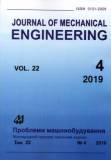R-функции в аналитическом описании поверхности беспилотного летательного аппарата, выполненного по схеме «летающее крыло»
Ключевые слова:
беспилотный летательный аппарат, R-функции, буквенные параметры, стандартные примитивыАннотация
Беспилотные летательные аппараты (БПЛА) становятся все более востребованными во всем мире. Область их применения весьма обширна. Они используются в военных целях, при доставке грузов, мониторинге окружающей среды, патрулировании границ, воздушной разведке и картографировании, контроле дорожного движения и др. Ряд важных достоинств БПЛА перед пилотируемой авиацией привел к более активному развитию этой отрасли, среди которых относительно небольшая стоимость при большой продолжительности и дальности полета, малые затраты на их эксплуатацию, возможность выполнять маневры с перегрузками, превышающими физические возможности человека. Проектирование БПЛА и системы управления невозможно представить без их математического моделирования. Для построения математических моделей созданы быстродействующие ЭВМ и современные программные средства, например такие, как программные комплексы Solid Works, Ansys CFX, POLYE и др. Возникает проблема задания и оперативного изменения геометрической информации для создания математической и компьютерной модели проектируемого БПЛА. На этапе проектирования могут быть решены многие задачи, которые ставятся перед исследователями при использовании БПЛА. При этом параметрическому заданию поверхностей летательных аппаратов уделяется недостаточно внимания. Расширение области применения аппарата теории R-функций для моделирования поверхностей БПЛА является актуальной научно-технической задачей. В данной работе впервые, с помощью теории R-функций, построено уравнение поверхности БПЛА, выполненного по схеме «летающее крыло» в виде единого аналитического выражения с буквенными параметрами. Такое уравнение может быть использовано как при решении различных практических задач, так и при разработке и изготовлении самого изделия, например, на 3D-принтере. Предложенный метод задания формы изделий с помощью ограниченного числа параметров может существенно сократить трудоемкость работ в CAD-системах в тех случаях, когда требуется просмотреть большое количество вариантов конструкции в поисках оптимального решения. В работе построено 14-параметрическое семейство поверхностей БПЛА, выполненных по схеме «летающее крыло». Меняя значения буквенных параметров, можно оперативно исследовать его различные формы.Библиографические ссылки
Fedorov, S. I., Khaustov, A. V., Kramarenko, T. M., & Dolgikh, V. S. (2016). Klassifikatsiya BPLA i sistemy ikh intellektualnogo upravleniya [Classification of UAVs and their intelligent control systems]. Otkrytyye informatsionnyye i kompyuternyye integrirovannyye tekhnologii – Open Information and Computer Integrated Technologies, no. 74, pp. 12–21 (in Russian).
Austin, R. (2010). Unmanned Aircraft Systems: UAVS Design, Development and Deployment. John Wiley and Sons, 332 p. https://doi.org/10.1002/9780470664797.
Arjomandi, M. (2006). Classification of Unmanned Aerial Vehicles. MECH ENG 3016. Aeronautical Engineering. TheUniversityofAdelaideAustralia, 49 p.
(2010). Unmanned Aircraft System Operation inUK. Airspace – Guidance: CAP 722. Civil Aviation Authority, 96 p.
Sheyko, T., Maksymenko-Sheyko, K., Sirenko, V., Morozova, A., & Petrova, R. (2019). Analytical identification of the unmanned aerial vehicles’ surfaces for the implementation at a 3D printer. Eastern-European Journal of Enterprise Technologies, vol. 1, no. 2 (97), pp. 48–56. https://doi.org/10.15587/1729-4061.2019.155548.
Rvachev, V. L. (1982). Teoriya R-funktsiy i nekotoryye yeye prilozheniya [R-functions theory and some of its applications]. Kiyev: Naukova dumka, 552 p. (in Russian).
Rvachev, V. L. & Sheiko, T. I. (1995). R-functions in boundary value problems in mechanics. Applied Mechanics Reviews, vol. 48, no. 4, pp. 151–188. https://doi.org/10.1115/1.3005099.
Maksimenko-Sheyko, K. V. (2009). R-funktsii v matematicheskom modelirovanii geometricheskikh obyektov i fizicheskikh poley [R-functions in mathematical modeling of geometric objects and physical fields].Kharkov: IPMashNAN Ukrainy, 306 p. (in Russian).
Lisin, D. A., Maksimenko-Sheyko, K. V., Tolok, A. V., & Sheyko, T. I. (2011). R-funktsii v kompyuternom modelirovanii dizayna 3D-poverkhnosti avtomobilya [R-functions in computer simulation of the design of the 3D surface of a car]. Prikladnaya informatika − Journal of Applied Informatics, no. 6 (36), pp. 78−85 (in Russian).
Загрузки
Опубликован
Выпуск
Раздел
Лицензия
Copyright (c) 2019 Tetiana I. Sheiko, Kyrylo V. Maksymenko-Sheiko, Volodymyr M. Sirenko, Anna I. Morozova

Это произведение доступно по лицензии Creative Commons «Attribution-NoDerivatives» («Атрибуция — Без производных произведений») 4.0 Всемирная.
Авторы, публикующиеся в этом журнале, соглашаются со следующими условиями:
- Авторы оставляют за собой право на авторство своей работы и передают журналу право первой публикации этой работы на условиях лицензионного договора (соглашения).
- Авторы имеют право заключать самостоятельно дополнительные договора (соглашения) о неэксклюзивном распространении работы в том виде, в котором она была опубликована этим журналом (например, размещать работу в электронном хранилище учреждения или публиковать в составе монографии), при условии сохранения ссылки на первую публикацию работы в этом журнале.
- Политика журнала позволяет размещение авторами в сети Интернет (например, в хранилищах учреждения или на персональных веб-сайтах) рукописи работы, как до подачи этой рукописи в редакцию, так и во время ее редакционной обработки, поскольку это способствует возникновению продуктивной научной дискуссии и позитивно отражается на оперативности и динамике цитирования опубликованной работы (см. The Effect of Open Access).

